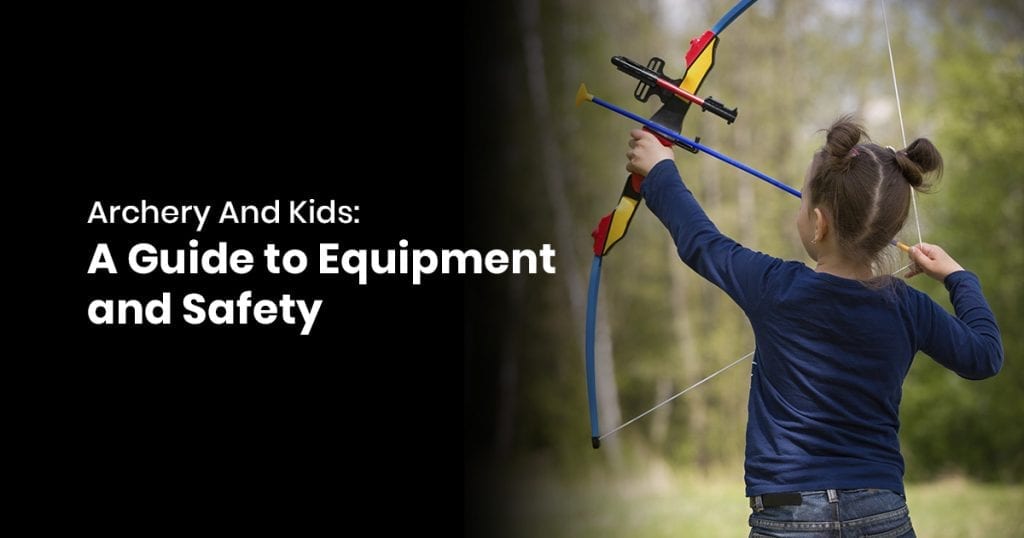Children often get an interest in archery, and who can blame them?
It looks (and is) ridiculously fun to control an arrow and decide where it’s going to land once it’s released from a bow.
Teaching them the right way to respect a bow and arrow, as well as the alternatives if they aren’t able to follow safety protocol, will give them an appreciation for archery and a way to get out their energy.
Unfortunately for them, it isn’t as simple as that, and children will need to be taught proper discipline with this potentially dangerous sport.
They’ll need to start small, but this guide is here to show you how to get them into archery without losing your mind and keeping them safe in the process.
How to Choose Archery Equipment for Kids
You have to account for their smaller size and expect to change out their equipment as they get older.
Bows are designed to work with your measurements, which is why you can find numerous bows in varying sizes for adults.
Knowing this, it’s important to choose archery equipment that’s going to work well with your child’s size, and upgrade with time.
Draw Weight
Draw weight is difficult to determine, but if it takes 15 lbs to reach maximum draw on a bow, it’s probably good enough for a small child to use.
Physical fitness and age (as well as size) will play a role in this. It should be difficult to pull back, but not to the point that your child’s arms are shaking and they’re heavily straining.
They should still be able to walk around while the bow is drawn, and focus on their aim instead of keeping the string pulled back.
Draw Length
This is arguably the most important part of the equipment, and it’s so easy to measure before you begin shopping.
Take a tailor’s tape measure, and have your child stand with their arms extended on either side. Run the measuring tape from one fingertip on the left hand, across their chest, to the fingertip on their right hand.
The number you receive needs to be divided by 2.5 to get the proper draw length. It’s basically a little more than the length of one arm.
Weight
The weight of the bow matters. Kids aren’t in a position to train and be physically excellent, and holding a bow engages more muscle groups than people realize.
Your deltoids (shoulder), core, arms and back muscles all activate while you’re pulling the bow up and retracting the string.
Grip
Kids are clumsy, and that’s okay. Just be sure to have a well-textured grip on the outside of that bow.
If you’re in the store with them when you pick it out, grab it and see how far that grip spreads across the bow.
You want to give them the option to find a holding position that works for them, and that can be a bit hard if the only area they can hold on to is narrow.
Sight
Whether it’s an aftermarket sight or simply the “iron sights,” you need to have some way to visibly see the target ahead.
This can come down to preference, but most children will find it easier to use some sort of sight until they get the hang of using a bow.
You can find colored attachment sights to make it fun for them, while still providing a better way to hit their mark.
Materials
There are a few materials that are associated with archery, namely aluminum in compound bows, wood in takedown bows, and fiberglass in the shafts of arrows, just to name a few.
Archery equipment materials matter: it’s a sign of how well you can trust it to withstand stress and use. The brand also has something to do with that, but that’s a conversation for another time.
Kids Archery Safety Tips
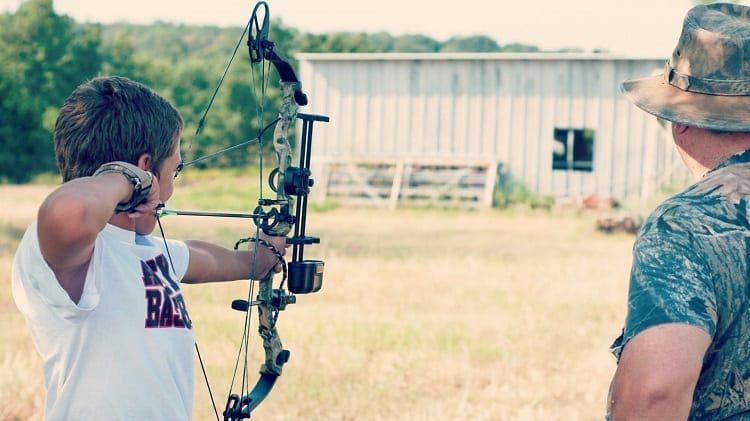
These quick and easy tips can be summarized in a sheet for your kids to study. Reinstate these every single time your child begins their archery practice.
- Do not point your bow at anyone, even if it is without an arrow. It gives an intimidating and potentially dangerous feeling knowing what could be in there and makes people feel uncomfortable.
- Do not dry fire your bow. Dry firing is pulling the bowstring back and releasing the tension without an arrow. This could lead to finger injuries to the user or breaking your bow.
- Only pull back arrows while the bow is facing the ground. One slip of the finger and a partially charged arrow could slip out and hurt someone. You’ll always see someone begin to pull back while the arrow is faced down and raise it as they gain control over it.
- No firing into the air. It’s impossible to predict where the arrow is going to land. It eliminates control, which is what your children need to have over their bow at all times.
- Wear an armed guard to prevent any issues with accidental dry firing, and overall protection.
- Do not use a bow with a higher maximum draw weight than the child had. If they’re using their friends’ new bow at a group training practice, but the friend got a higher draw weight bow, they really, really shouldn’t be using it. Draw weight is relative to arm length and body size.
- Understand and avoid overdrawing. This is when you pull the string on the bow too far back, causing it to undergo unnecessary tension that wasn’t intended during design. Kids can get a bit hectic and try to test their strength with how far back they can pull the bowstring. While it isn’t recommended for children to be using recurve bows, if they do, this tension can cause it to snap and the bowstring to flick back like a whip.
- Teach them how to string their own bow with a bow stringer. This avoids injury, shows them how to store their bows (they should always be stored unstrung or half-strung), and prevents damage to the bow.
- Inspect before every single use. Whether it’s the bow, arrows, arm guards or quiver, it’s all going to undergo stress. If you have a takedown bow for your child, it’s especially important to check the way the limbs are attached, and look for cracks or splits in the body. Attend to these straight away.
- Wax strings after every 100 shots. This is something that older children/teenagers should learn to do for themselves. Failing to wax the string could result in misfiring or not hitting your mark, and eventual bowstring degradation.
- Don’t run to retrieve arrows. Not only is it dangerous to run in an open arrow field (like a public practice area), but it’s also unwise to run in general, especially with a bow in your hand.
- Wear bright-colored clothing and/or reflective strips if practicing outside. On a misty morning, you don’t want to be wearing anything that can get lost in the horizon if you’re in a public area. While most people will do good to announce when they are going to shoot and inspect the area beforehand, it’s a lot like driving: assume everyone around you doesn’t know what they’re doing.
- Keep your ears open. When someone shouts “Hold,” it’s time to stop moving or get to a safe spot. That’s another archer telling you to stay put because either someone is going to fire, or there’s a problem.
There can be a lot to learn, but that’s part of the fun of it.
Your children are (eventually) going to be hurling sharp bits of steel through the air towards their targets as they progress in their learning.
That can be scary, but it’s also exhilarating and fun, and that’s the part that should be celebrated.
How to Make Sure They Learn Them
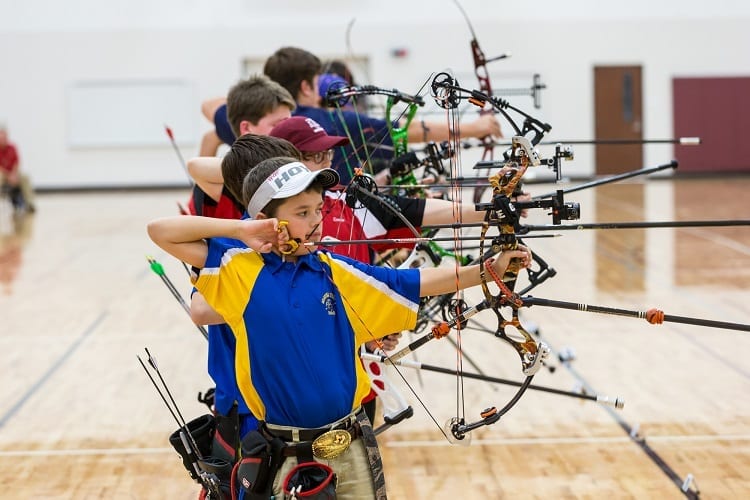
Memorization and recitation.
It’s not really going to benefit them to remember all fifty state capitals, but drilling these safety tips into their head is something they can actually draw on in the future, and put that information to good use.
You basically need to have them recite and remember a list of the most crucial safety tips and regulations, while also having them show you, in practice, how to apply what they’ve learned.
It can be a little aggravating, but ignore the rolling of the eyes and run through the list with them each and every time anyway.
It helps to prevent them from forgetting anything or making a miscalculation when trying to get ready for archery. You can do one of the following to make sure they remember their safety tips and information.
Recite at Practice
Right at the beginning of practice or their archery session, run through the list with them.
Ask questions, request answers, and if they get it wrong just say the answer and move on to the next. Mark any that they got wrong the first time, then run through those same ones again at the end.
This ensures that they aren’t just trying to yes you to death, but also gives them the answers on the spot since safety is far more important than whatever their final “score” would be.
Create Acronyms
Find clever ways to make acronyms to remember safety tips. You can use E.A.T. for Eyes Always on Target, or something along those lines.
When there’s a bit of rhythm to it, kids tend to remember it. It’s a quicker way to run through safety protocol before a practice session, too.
Cheat Sheet
At the end of the day, it just matters that they learn and understand safety. Give them a cheat sheet to take with them when they go to practice.
This will especially be helpful if you aren’t around during practice times if they’re after school, or far from home.
What is the Best Age to Start Archery for Kids?
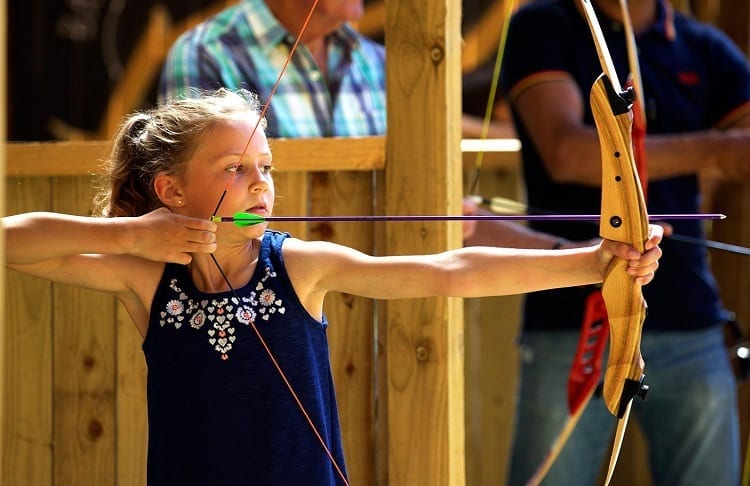
About eight years old.
Anything less than that, and they may not have the attention span that’s required to focus on the task at hand.
Being able to stand still and keep your thoughts clear and concentrated is key to archery, regardless of your age, and if they are incapable of that, you’re better off starting them with a toy set.
If your child is gifted or simply has a great attention span when it comes to their interests or things that they love, then, by all means, start them as soon as they’re ready.
Typically, eight is a good benchmark age in childhood development where they’re able to perform viable risk assessment, and better pay attention to critical instruction and safety measures.
How Young is Too Young to Start Archery?
Every child is different, and there’s no preset age that acts as a barrier between being able to learn, and not being able to learn.
A six-year-old may be more enthused and ready to start than an eight-year-old; it all depends. There’s this age-old sentiment that you should have your children try and learn things while they’re young.
That gives them time to hone their skills, improve, maybe even make it to the big leagues (for most sports), right? There’s nothing wrong with that unless you force it. Children do things when they are ready.
Use this simple three-point checklist to see if they’re ready to start archery or not.
- Does your child have the physical strength to pull back a bowstring? Children’s bows have less of a draw weight requirement than adult bows, but if they can’t even manage that, then they are not physically ready to begin archery. They should be able to hold a bowstring for about seven seconds before they actually begin archery.
- Are they mature enough to understand safety and danger? Every child knows not to touch the stove (probably because at one point they touched the stove), but this is different. This is something they need to understand well before they begin shooting: bows can be weapons, and it won’t just hurt them.
- Can they hold their attention span? We don’t mean to segregate children with ADD and ADHD, but the focus is very important for both safety and success. If they aren’t able to focus on the target and aim their shots properly, then they shouldn’t be partaking in archery in the first place.
Keep in Mind
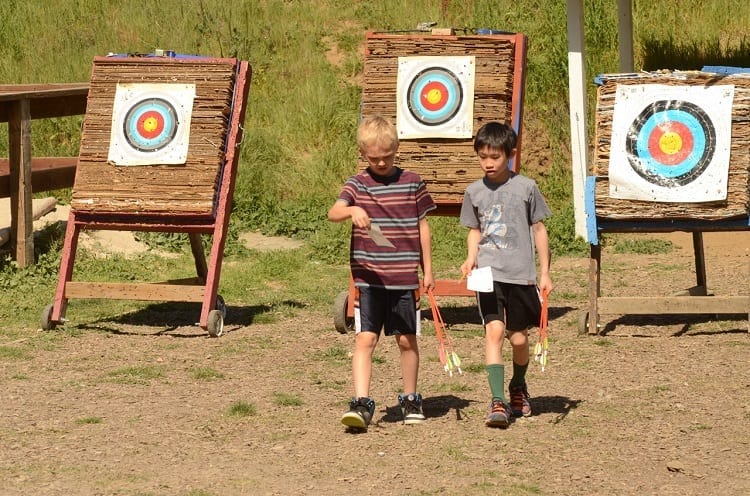
At the end of the day, they’re kids, and they’re going to make mistakes.
Keep these bits of information in mind at all times to keep yourself cool, and upkeep their interests. Stress will cause a child to stop caring about something that they truly enjoy or have an interest in.
Kids Make Mistakes
Safety is here to prevent those mistakes from being terrible or painful, but they are going to make mistakes.
They may genuinely forget a step of the safety instructions (after all, there is a lot), but it’s going to get easier with time.
If it’s something that they truly enjoy, they’ll be able to focus and avoid more mistakes as they progress. Remember that they are kids, and their mistakes will decrease with experience.
It’s Your Responsibility to be Calm
It gets frustrating. Children are learning how to have patience, and they might get fed-up with trying to learn.
Any child can get flustered and give up on something; it’s a defense mechanism to avoid embarrassment and ridicule, but you can’t let them just throw away this golden opportunity.
Archery evokes discipline and shows your child how to discipline themselves to get the outcome that they’re after.
Be calm with them, let them take their rest from archery, but don’t let them just throw in the towel because of a learning curve. They’ll get it in time, and you’ll be there to coach them every step of the way.
Supervision is Always Required
Regardless of how equipped, they are with a bow, if they are under the age of sixteen, you should be close with full visibility over everything that they do.
Whether you need to remind them of form to keep the shot straight, or to listen to a safety measure that they are otherwise neglecting, it’s going to be hard to do that if you aren’t right there by their side during the entire process.
Foster a Love for Archery Now
Your children can grow up to be fantastic archers if you’re able to foster a love and appreciation for the sport.
Kids archery is a fun and exciting sport that can help improve your skill level and hand-eye coordination. It provides an easier access to outdoor activities and allows you to enjoy nature while practicing your archery skills.
One of the biggest things to remember when starting archery is to always prioritize safety and proper care of your equipment. Regular practice sessions are essential for improving your accuracy and aim.
Target practice is a great way to measure your progress and challenge yourself in extreme circumstances. Good luck understanding wind speed an important factor and its effect on your arrow’s single shot trajectory is important for consistent shooting. Kinetic energy plays a crucial role in the power and penetration of your arrows.
New look of kids archery is a fun and exciting sport on public land that can help improve your skill level and hand-eye coordination, make use of all that video games time. It provides an easier access to outdoor activities and allows you to enjoy nature while practicing your archery skills for a long time.
One of the key benefits of kids archery is the development of focus and concentration. As children practice archery, they learn to block out distractions and focus on their target. This skill can be applied to other areas of their life, such as schoolwork or sports. Additionally, archery helps proper form, improve hand-eye coordination and fine motor skills. By consistently practicing archery, children can enhance their overall physical and mental abilities with rigorous training.
Another great aspect of kids archery in the United States is the opportunity for social interaction. Whether it’s practicing with friends or participating in competitions and seeing great places. Archery provides a platform for children to connect with others who share the same interest. This can lead to the formation of lasting friendships, a real good thing and a sense of community. Additionally, participating in archery competitions can teach children valuable lessons in sportsmanship and teamwork.

